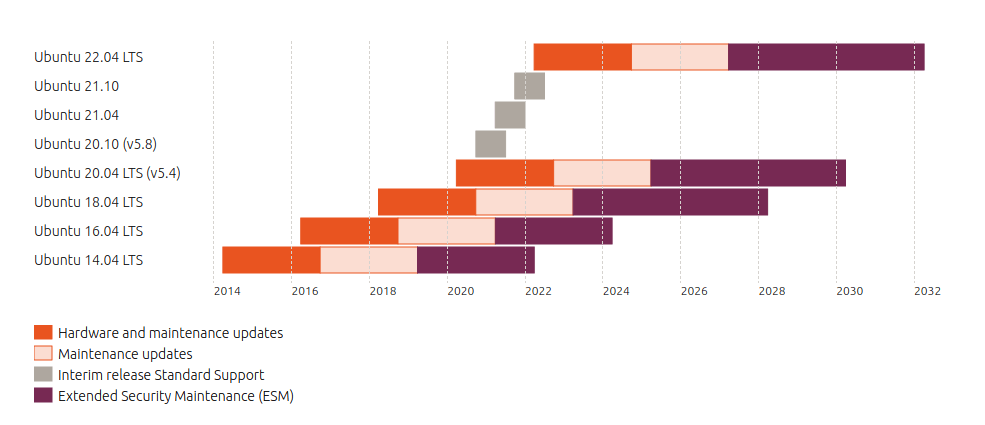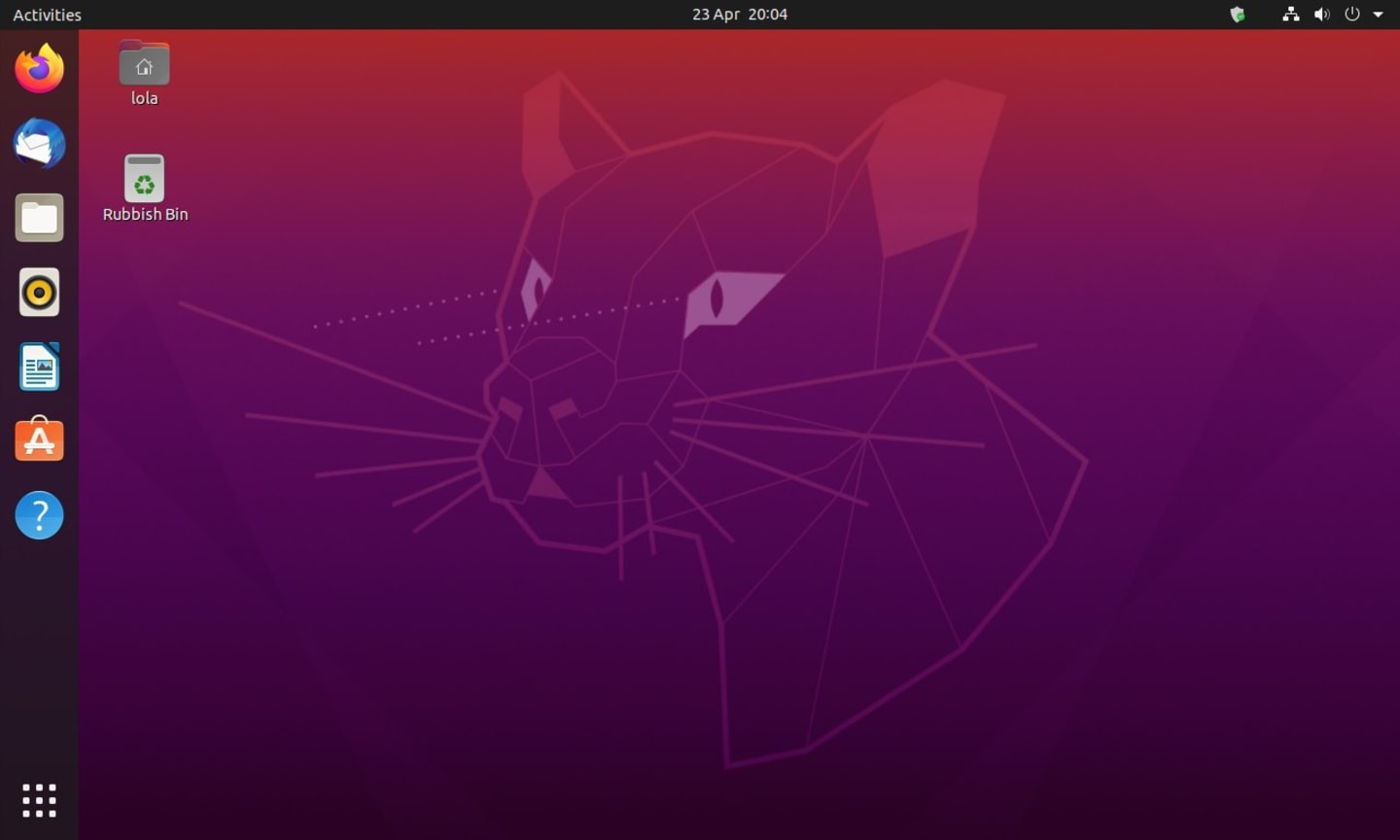Ubuntu’s flagship operating system is hardly a thing of a novelty since we had been anticipating its release for a good while. In April 2020, Canonical officially announced the release of the next iteration of its Ubuntu operating system which is the long-term support 20.04 (Focal Fossa).
The recommended minimum system requirements are a 2 GHz dual-core processor, 25 GB free hard drive space, and 4 GB RAM.
For a clean installation, you need either a DVD drive or a USB port for the installer media. Internet access during the installation will be helpful so that you can download any recent updates at once. Of course, it’s possible to download and install any of the Ubuntu flavors as we did here.
[ You might also like: Which Ubuntu Flavor Should You Choose? ]
Ubuntu Lifecycle and Release Cadence
Canonical uses a scheme/strategy to publish new Ubuntu versions regularly. This release scheme (made up of version numbers and release types) is referred to as Ubuntu’s cadence, and it enables the community, developers, and businesses to plan their roadmaps with a certainty of when they will access newer open-source upstream capabilities.
Ubuntu releases, therefore, get a development codename that is reasonably versioned by the year and month of delivery (YY.MM), and by whether it is a version published every 2 years i.e. LTS standing for long-term support. LTS versions typically have a life span of 2 years and an extended security maintenance period that ranges between 2 to 5 years.

Every LTS version is published biannually in April as ‘enterprise grade’ releases of Ubuntu and is the most popular among users with an estimated 95% of all Ubuntu installations being Long-term support releases. Every 6 months between LTS versions, Canonical publishes interim production-quality releases which are supported for 9 months and have no extended security maintenance.
In our case, Ubuntu 20.04 LTS Focal Fossa is the April release while Ubuntu 20.10 is the interim release. And if you’ve been following thus far, you have probably already figured out that the next LTS release will be sometime in April 2022 with its ‘End of Life’ slated for April 2027.
Ubuntu 20.04’s development cycle came to an end after a thorough community test that lasted for 6 months. The current version is Ubuntu 20.04.2.0 LTS and it’s got a long list of features and improvements under the hood so we might just have to give a more thorough walkthrough of the operating system over the weekend.
New features in Ubuntu 20.04 LTS
Ubuntu Desktop & Default Apps
As of January 2021, Focal Fossa’s Desktop flavor gained new major kernel versions every 6 months and this will continue until summer 2022 even for users who installed Ubuntu Desktop before then.
When you boot into your system, the first things you might notice are its new graphical boot splash and refreshed Yaru theme with light/dark theme switching.
GNOME 3.36 features a new lock screen design, system menu design, and app folder design. It also offers smoother performance and lower CPU usage for mouse movements, window and overview animations, JavaScript execution, and window movement.

If you work a lot with graphics then there are happy days for you because GNOME 3.36 and later now enjoy 10-bit deep colour support and X11 fractional scaling.
Concerning major default apps, Ubuntu 20.04 ships with updated versions of Mesa OpenGL stack, PulseAudio, Firefox, LibreOffice, Thunderbird, and BlueZ.
Kernel Upgrades
Firstly, Ubuntu 20.04 is based on the Linux kernel release series 5.4 which is long-term support. Notable improvements include support for new hardware including AMD Navi 12 and 14 GPUs, Intel Comet Lake CPUs and initial Tigae Lake platforms, Arcturus and Renoir APUs alongside Navi 12 + Arcturus power features.
exFAT file systems are now supported, WireGuard VPN support is built-in, lockdown in integrity mode is enabled, and support for virtio-fs for file sharing filesystems without virtualized guests and fs-verify for detecting file modifications has been added.
If you’re familiar with RISC-V architecture, then you may be happy to know that Focal Fossa now ships with RISC-V image for SiFive HiFive Unleased and it can also be used as a VM with QEMU on any machine running Ubuntu 20.04.
Storage/File Systems
Ubuntu Focal Fossa ships with ZFS 0.8.3 which brings many features such as device removal, Pool TRIM, sequential scrub and resilver (performance), and native encryption (with hardware acceleration enabled by default).
Network Configuration
Ubuntu 20.04’s netplan.io ships with several new features including support for GSM modems via the NetworkManager backend via the modems section, the ability to set ipv6-address-generation for the NetworkManager backend and emit-lldp for networkd, and the ability to add WiFi flags for bssid/band/channel settings.
In addition to that, users can now configure Virtual Functions for individual SR-IOV physical functions which can be set as any other networking device, and set hardware VLAN VF filtering.
Toolchain Upgrades
Ubuntu 20.04 LTS comes with a renewed state-of-the-art toolchain included with new upstream releases of Glibc 2.31, OpenJDK 11, Python 3.8.2, and other languages.
Other Base System Changes
The Snap Store has now replaced Ubuntu Software Center as the default software for installing and managing packages and snaps.
20.04 LTS ships with Python 3.8 in the base system and the remaining packages in Ubuntu which require 2.7 have been updated to use usr/bin/python2 as their interpreter and /usr/bin/python is not present by default on clean installations.
[mks_button size=”medium” title=”Download Ubuntu 20.04 (Focal Fossa)” style=”squared” url=”https://ubuntu.com/download/desktop/thank-you?version=20.04.2.0&architecture=amd64″ target=”_blank” bg_color=”#529b30″ txt_color=”#FFFFFF” icon=”fa-download” icon_type=”fa” nofollow=”1″]
As hinted above, the maintenance updates for Focal Fossa (Ubuntu Desktop, Server, Cloud, and Core) will be provided for 5 years until April 2025 while the remaining flavors will be supported for 3 years. They all include additional security support which is available with Extended Security Maintenance (ESM).
To check the support status of your Ubuntu system:
$ ubuntu-security-status
For earlier versions of Ubuntu, use this command:
$ ubuntu-support-status
What has been your experience with Ubuntu 20.04 Focal Fossa so far? And are you running its latest version or have you switched to Ubuntu 20.10 to enjoy the more cutting-edge upgrades? Tell us all about your experience in the comments section below.
